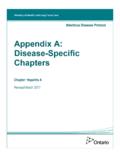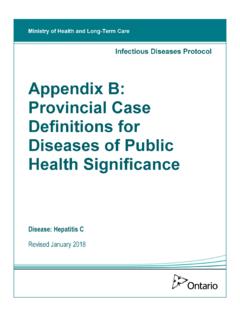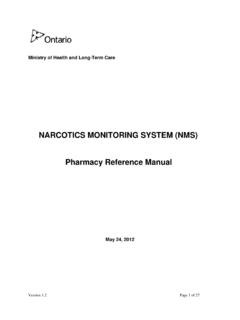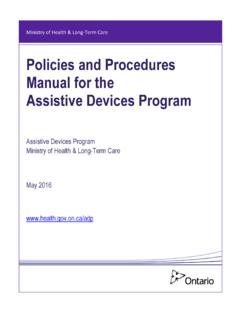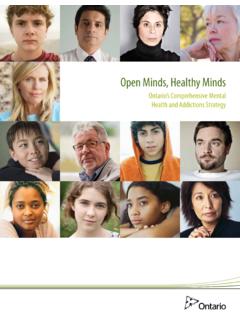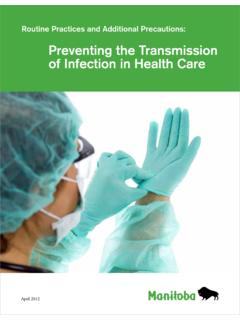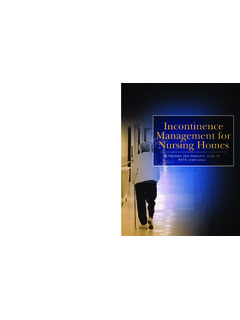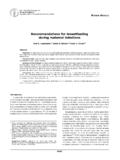Transcription of Appendix A: Disease-Specific Chapters
1 Infectious Diseases Protocol Appendix A: Disease-Specific Chapters Chapter: Salmonellosis Revised December 2014 2 Salmonellosis Communicable Virulent Health Protection and Promotion Act: Ontario Regulation 558/91 Specification of Communicable Diseases Health Protection and Promotion Act: Ontario Regulation 559/91 Specification of Reportable Diseases Aetiologic Agent Salmonellosis is caused by the bacterium, Salmonella, a Gram-negative, non-spore forming bacillus that has over 2,500 serotypes, belonging to the Enterobacteriaceae , 2 Nomenclature for Salmonella is Salmonella enterica subsp enterica. Serotypes include Typhimurium, Enteriditis, Case Definition Surveillance Case Definition See Appendix B Outbreak Case Definition Outbreak case definition varies with the outbreak under investigation.
2 For example, confirmed outbreak cases should at a minimum meet the criteria specified for the provincial surveillance confirmed case classification. Consideration should be given to the following when establishing an outbreak case definition: Clinical and/or epidemiological criteria; The time frame of occurrence; The geographic location(s) or place(s) where cases live or became ill/exposed; Special attributes of cases ( age, underlying conditions); and Further strain typing ( serotype, phage type (PT), pulsed field gel electrophoresis (PFGE)) as appropriate, which may be used to support linkage. Cases may be classified by levels of probability ( confirmed probable and/or suspect).
3 Identification Clinical Presentation Salmonellosis causes a spectrum of illness ranging from asymptomatic gastrointestinal tract carriage to gastroenteritis, bacteremia and focal , 2 Symptoms can occur within 6-72 hours, however usually appear 12-36 hours after exposure. Symptoms include sudden onset of headache, fever, abdominal pain, diarrhea, nausea and sometimes vomiting. Some 3 infected individuals may experience bloody Dehydration, especially among the young, the elderly and those with impaired immune systems can be severe, and may result in hospitalization. Reactive arthritis is a recognized sequela of , 4 Death is , 2, 5 Foodborne Salmonella infection can lead to urinary tract infection, particularly among elderly women.
4 This is generally caused either by self-contamination of the urinary tract due to improper wiping or as a result of Diagnosis See Appendix B for diagnostic criteria relevant to the Case Definition. For further information about human diagnostic testing, contact the Public Health Ontario Laboratories or refer to the Public Health Ontario Laboratory Services webpage: Epidemiology Occurrence Salmonellosis is the second most common enteric infection in Ontario. The number of cases typically peaks in the summer months. S. Enteritidis, S. Typhimurium and S. Heidelberg are the three most common serotypes in Ontario. Between 2007 and 2011, an average of 2,564 cases per year of salmonellosis was reported in Ontario.
5 Please refer to the Public Health Ontario (PHO) Monthly Infectious Diseases Surveillance Reports and other infectious diseases reports for more information on disease trends in , 8 Occurrence is worldwide. It is estimated that only 1% of all infections are ever clinically recognized. The incidence rate of infection is highest among infants and young children. About 60-80% of all cases occur sporadically. Large outbreaks in hospitals, institutions for children, restaurants, nursing homes and the community are common. Outbreaks usually arise from food contaminated at source or during handling by an ill person or carrier, although person-to-person transmission can Reservoir Domestic and wild animals, including poultry, swine, cattle, rodents, and pets such as iguanas, tortoises, turtles, terrapins, chicks and other baby poultry, dogs, cats, hamsters, hedgehogs, amphibians, lizards, snakes, frogs, toads, newts and , 2 Acute cases, convalescent carriers and mild and unrecognized cases constitute an important source of 4 Modes of Transmission Most types of Salmonella live in the intestines of animals and birds.
6 Infection is acquired by the ingestion of organisms in food contaminated by the stool of an infected animal or person. The most common food vehicles include poultry and poultry products ( raw/undercooked chicken nuggets), raw milk and raw milk products, contaminated water, meat and meat products, raw/undercooked eggs and egg products, and raw fruits and vegetables. Raw alfalfa sprouts, raw mung bean sprouts, and spicy sprouts have been linked to a number of outbreaks in Canada and the United , 10 In addition to the animals identified in the Reservoir section above, Salmonella has recently been found in pet foods and was associated with a multistate wide outbreak in the US and , 12 Fecal-oral transmission from person-to-person has also been observed when diarrhea is present, especially in institutional Infants and stool incontinent adults pose a greater risk of transmission than do asymptomatic Incubation Period From 6-72 hours.
7 Usually about 12-36 Longer incubation periods of up to 16 days have been documented, and may not be uncommon following low-dose , 13 Period of Communicability The median duration of fecal shedding of non-typhoidal Salmonella after intestinal infection has been estimated as 1 month in adults and 7 weeks in children under 5 years of In one study, 45% of children under 5 years continued to shed Salmonella organisms 12 weeks after infection, compared to only 5% of older children and Antibiotic usage may also prolong the duration of fecal shedding,1, 2 but human carriage of non-typhoidal Salmonella species beyond one year is , 15 Host Susceptibility and Resistance Susceptibility is general and usually increased by achlorhydria, antacid treatment, gastrointestinal surgery, prior or current broad-spectrum antibiotic therapy, neoplastic disease, and other immunosuppressive conditions including Reporting Requirements To local Board of Health Individuals who have or may have salmonellosis shall be reported as soon as possible to the medical officer of health by persons required to do so under the Health Protection and Promotion Act, 1990 (HPPA).
8 16 To the Ministry of Health and Long-Term Care (the ministry) or Public Health Ontario (PHO), as specified by the ministry Report only case classifications specified in the case definition using the integrated Public Health Information System (iPHIS), or any other method specified by the ministry within 5 one (1) business day of receipt of initial notification as per iPHIS Bulletin Number 17: Timely Entry of The minimum data elements to be reported for each case are specified in the following: Ontario Regulation 569 (Reports) under the HPPA;18 , 16 The iPHIS User Guides published by PHO; and Bulletins and directives issued by PHO. Prevention and Control Measures Personal Prevention Measures Preventive measures:1 Minimize cross-contamination through the use of safe food handling techniques.
9 Practice good hand hygiene after using sanitary facilities, after assisting others with personal care ( diapering or toileting), after handling raw foods, pets and other animals, and before food handling. Cook and reheat food thoroughly to the appropriate temperatures. For temperatures, see the ministry s publication Food Safety: Cook available at #4 Follow manufacturer s directions for cooking and re-heating of high-risk food items (such as raw or frozen poultry and processed poultry products). For high risk individuals, avoid consuming raw sprouts. Avoid preparing or serving food while ill. Treat or boil water intended for consumption. Avoid drinking raw or unpasteurized milk.
10 For children, older adults, pregnant women and the immunocompromised, avoid consuming dairy products made from unpasteurized or raw milk. Keep storage of hazardous food at room temperature for no more than 2 hours. For more food safety prevention measures, please see the ministry s food safety frequently asked questions available from 6 Infection Prevention and Control Strategies Strategies: Educate food handlers and the general public about the importance of hand washing before, during and after food preparation; proper food handling and storage especially avoiding cross contamination between raw and cooked foods; maintaining a sanitary Implement routine practices and contact precautions for incontinent and diapered Refer to Public Health Ontario s website at to search for the most up-to-date Provincial Infectious Diseases Advisory Committee (PIDAC) best practices on Infection Prevention and Control (IPAC).

